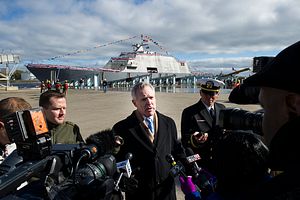The Freedom-class Littoral Combat Ship (LCS) USS Detroit completed acceptance trials on July 15, the U.S. Navy announced on July 22. The acceptance trial was the last significant milestone before the ship’s transfer to the U.S. Navy; it is slated to be commissioned in late October.
“During the trial, the Navy conducted comprehensive tests of the littoral combat ship (LCS) intended to demonstrate the performance of the propulsion plant, shiphandling and auxiliary systems,” the U.S. Navy notes. “While underway, the ship successfully performed launch and recovery operations of the 11-meter rigid hull inflatable boat, conducted surface and air self-defense detect-to-engage exercises, and demonstrated the ship’s maneuverability.”
Once commissioned, the USS Detroit will be transferred to the West Coast, where she will join three other Freedom-class LCSs: the USS Freedom, USS Forth Worth, and USS Milwaukee, all homeported in San Diego. The U.S. Navy expects to add at least nine more Freedom-class variants of the LCS to its surface warship fleet in the coming years. In addition, there are also 13 Independence-class variants of the LCS currently under construction. The U.S. Navy also plans to build a more heavily-armed and armored LCS variant, designated a frigate, as a response to advances in effective counter-swarm defense.
In December, U.S. Defense Secretary Ashton Carter ordered the U.S. Navy to reduce the number of Littoral Combat Ships (LCS) to be built from 52 to 40. The reduction was vehemently opposed by some U.S. lawmakers and the industry teams that designed and are currently building the two LCS variants: Lockheed Martin and Austal USA. (According to Politico, Austal USA employed 12 lobbyists and Lockheed Martin employed 70 lobbyists to help fight the reduction in the number of LCSs in Washington D.C.)
The U.S. Navy will equip the LCS with a new over-the-horizon missile by the end of 2016, as part of a new warfighting concept known as “distributed lethality:”
The U.S. Navy intends to equip its fleet of LCSs with both the RGM-84D Harpoon Block 1C and the fifth-generation over-the-horizon Kongsberg Naval Strike Missile (NSM).(A NSM was test-fired from the USSCoronado in 2014.) However, as of now, neither the Harpoon nor NSM have been integrated with the combat system of the LCS. “Harpoon in the present installation is a stand-alone weapon system,” Larson said. But this will change by the end of the year.
As I noted elsewhere, all variants of the LCS are specifically tailored for shallow coastal waters and can customize around 40 percent of its volume to adapt to different types of mission packages, including surface warfare, mine countermeasures, and anti-submarine warfare. However, the LCS’s anti-mine warfare technology failed repeatedly in tests and might be dropped all together.
In February, in a letter to Secretary of the Navy Ray Mabus and the U.S. Navy’s chief of naval operations, Admiral John Richardson, the senior leaders of the U.S. Senate Armed Services Committee—Senators John McCain and Jack Reed—pointed out delays in initial operational testing of LCS mine countermeasure warfare, surface warfare, and anti-submarine warfare mission packages.
































